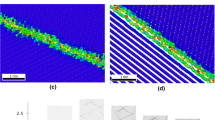Abstract
The dynamics and energetics of intergranular crack growth along a flat grain boundary in aluminum is studied by a molecular-dynamics simulation model for crack propagation under steady-state conditions. Using the ability of the molecular-dynamics simulation to identify atoms involved in different atomistic mechanisms, it was possible to identify the energy contribution of different processes taking place during crack growth. The energy contributions were divided as: elastic energy—defined as the potential energy of the atoms in fcc crystallographic state; and plastically stored energy—the energy of stacking faults and twin boundaries; grain-boundary and surface energy. In addition, monitoring the amount of heat exchange with the molecular-dynamics thermostat gives the energy dissipated as heat in the system. The energetic analysis indicates that the majority of energy in a fast growing crack is dissipated as heat. This dissipation increases linearly at low speed, and faster than linear at speeds approaching 1/3 the Rayleigh wave speed when the crack tip becomes dynamically unstable producing periodic dislocation bursts until the crack is blunted.









Similar content being viewed by others
Notes
For example, the formation energy of a vacancy for the interatomic potential used in this study [19] is 0.64–0.68 eV/atom, while the strain energy for 1% strain is only 0.001 eV/atom.
References
Kumar KS, Suresh S, Chisholm MF, Horton JA, Wang P (2003) Acta Mater 51:387
Wolf D, Yamakov V, Phillpot SR, Mukherjee AK, Gleiter H (2005) Acta Mater 53:1
Griffith AA (1920) Philos Trans Roy Soc Lond A221:163
Orowan E (1945) Trans Inst Eng Shipbuilders Scotl 89:165
Irwin GR (1948) Fracture Dynamics in Fracture of metals. American Society of Metals, Cleveland, p. 147
Kysar JW (2003) J Mech Phys Solids 51:795
Wolf D (1990) J Mater Res 5:1708
Hoagland RG (1997) Philos Mag A 76:543
Cleri F, Phillpot SR, Wolf D (1999) Interface Sci 7:45
Farkas D (2000) Philos Mag A 80:1425
Farkas D, Van Swygenhoven H, Derlet PM (2002) Phys Rev B 66:060101
Rudd RE, Belak JF (2002) Comp Mater Sci 24:148
Golubovic L, Peredera A, Golubovic M (1995) Phys Rev E 52:4640
Grujicic M, Zhao H, Krasko GL (1997) Int J Refract Metals Hard Mater 15:341
Gumbsch P, Zhou SJ, Holian BL (1997) Phys Rev B 55:3445
Gumbsch P (1999) Mat Sci Eng A 260:72
Heino P, Häkkinen, Kaski K (1998) Phys Rev B 58:641
Stampfl J, Kolednik O (2000) Int J Fracture 101:321
Mishin Y, Farkas D, Mehl MJ, Papaconstantopoulos DA (1999) Phys Rev B 59:3393
Nose S (1984) J Chem Phys 81:511
Barber M, Donley J, Langer JS (1989) Phys Rev A 40:366
Honeycutt JD, Andersen HC (1987) J Phys Chem 91:4950
Clarke AS, Jonsson H (1993) Phys Rev E 47:3975
Dahmen U, Hetherington JD, O’keefe MA, Westmacott KH, Mills MJ, Daw MS, Vitek V (1990) Philos Mag Lett 62:327
Tadmor EB, Hai S (2003) J Mech Phys Solids 51:765
Yamakov V, Wolf D, Phillpot SR, Gleiter H (2002) Nat Mater 1:45
Yamakov V, Wolf D, Phillpot SR, Gleiter H (2003) Acta Mater 51:4135
Yamakov V, Wolf D, Phillpot SR, Mukherjee AK, Gleiter H (2003) Philos Mag Lett 83:385
Parrinello M, Rahman A (1981) J Appl Phys 52:7182
Yamakov V, Saether E, Phillips DR, Glaessgen EH (2006), J Mech Phys solids 54:1899
Weertman J. Weertman JR (1992) Elementary dislocation theory. Oxford University Press, New York
Schiotz J, Vegge T, Di Tolla FD, Jacobsen KW (1999) Phys Rev B 60:11971
Rice JR (1992) J Mech Phys Solids 40:239
Yamakov V, Saether E, Phillips DR, Glaessgen EH (2005) Phys Rev Lett 95:015502
Abraham FF, Brodbeck D, Rafey RA, Rudge WE (1994) PhysRev Lett 73:272
Abraham FF (2001) J Mech Phys Solids 49:2095
Ching ESC (1994) Phys Rev E 49:3382
Sharon E, Gross SP, Fineberg J (1996) Phys Rev Lett 76:2117
Acknowledgements
V. Yamakov and D. R. Phillips were sponsored through cooperative agreement NCC-1-02043 with the National Institute of Aerospace and contract NAS1-00135 with Lockheed Martin Space Operations, respectively.
Author information
Authors and Affiliations
Corresponding author
Rights and permissions
About this article
Cite this article
Yamakov, V., Saether, E., Phillips, D.R. et al. Dynamics of nanoscale grain-boundary decohesion in aluminum by molecular-dynamics simulation. J Mater Sci 42, 1466–1476 (2007). https://doi.org/10.1007/s10853-006-1176-3
Received:
Accepted:
Published:
Issue Date:
DOI: https://doi.org/10.1007/s10853-006-1176-3




